Osteogenesis Imperfecta (OI) (final)
1/16
Earn XP
Description and Tags
Name | Mastery | Learn | Test | Matching | Spaced |
|---|
No study sessions yet.
17 Terms
What is Osteogenesis Imperfecta (OI) often referred to as?
And it is characterized by what 3 things?
it is an inherited disorder of what tissue, or what else?
what type of collagen is missing and how does this affect the bones in 2 ways?
Several what has been identified for OI?
- aka brittle bones disease,
characterized by lax joints, weak muscles, diffuse osteoporosis
- inherited disorder of connective tissue, or novel mutation
type I collagen missing —> bones are weak and fragile
- several causative factors have been identified
1978 Sillence and Danks classified how many genetic types of OI?
it has expanded to how many?
Which types affects COL1A1 and COL1A2?
encode for which type of collagen?
Which types do not have type I collagen defect?
classified 4 genetic types
expanded to over 20 types
I-IV affect COL1A1 and COL1A2
type I collagen
V-XXI do not have type I collagen defect
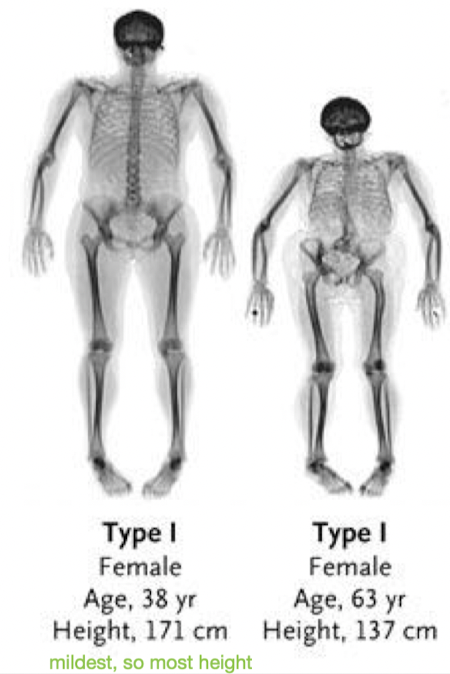
In type I OI, whats the range of bone fragility? how many fractures?
how much bone malformation?
when do most fractures occur?
what is the birth height/weight?
are the muscles strong/weak?
Mild to moderate bone fragility with few to several fractures
Little or no bone malformation
Most fractures occur before puberty
Normal birth height/weight
Muscle weakness
In type 1 OI:
joint laxity or hypomobility?
what feet position?
dislocations and what?
what is life expectancy?
associated w/ what color sclera, shape of face, and type of hearing loss?
Joint laxity
Flat feet
Dislocations and sprains
Average life expectancy
Associated with blue sclera, triangle face, and conductive hearing loss
How severe is Type II OI?
How much bone fragility?
Not compatible with what?
How much do not survive and by when?
- most severe form
extreme bone fragility
- not compatible with life
- 80% do not survive past 1 week
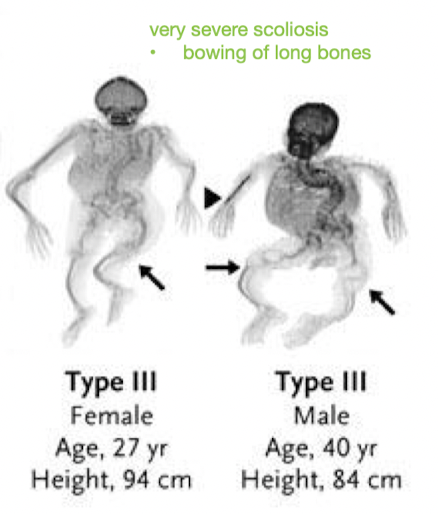
Is OI Type III often autosomal dominant or recessive inheritance?
How bad is the presentation?
Progressive deformity of what 3 bones? = ?
What else?
- often autosomal dominant, rarely recessive
- severe presentation
- long bones, skull, and spine = short stature
- dentinogenesis imperfecta 45%
In OI type 3:
How does type III affect teeth?
What about hearing loss?
How bad/good is the kyphoscoliosis?
what may it result in what?
- dentinogenesis imperfecta 45%
- hearing loss common
- kyphoscoliosis - severe
may result in respiratory compromise
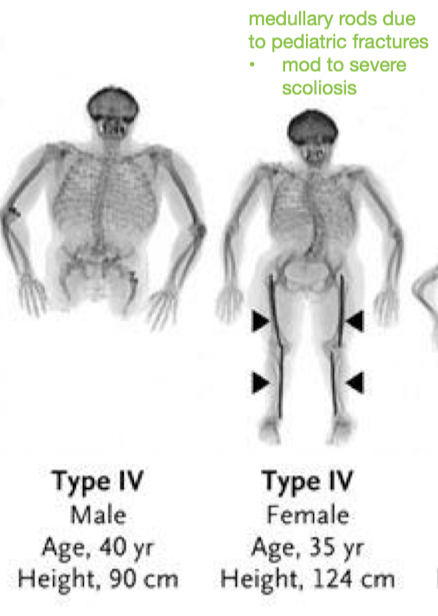
How much bone fragility in OI Type IV?
which deformity?
Is there dentinogenesis imperfecta?
What about hearing loss?
Prognosis for ambulation?
- Mild to moderate bone fragility
Long bone deformity
- Dentinogenesis imperfecta - common
- Variable hearing loss
- Prognosis for ambulation is excellent
What is the order from mild to severe of the 4 types of OI?
1 - 4 - 3 - 2
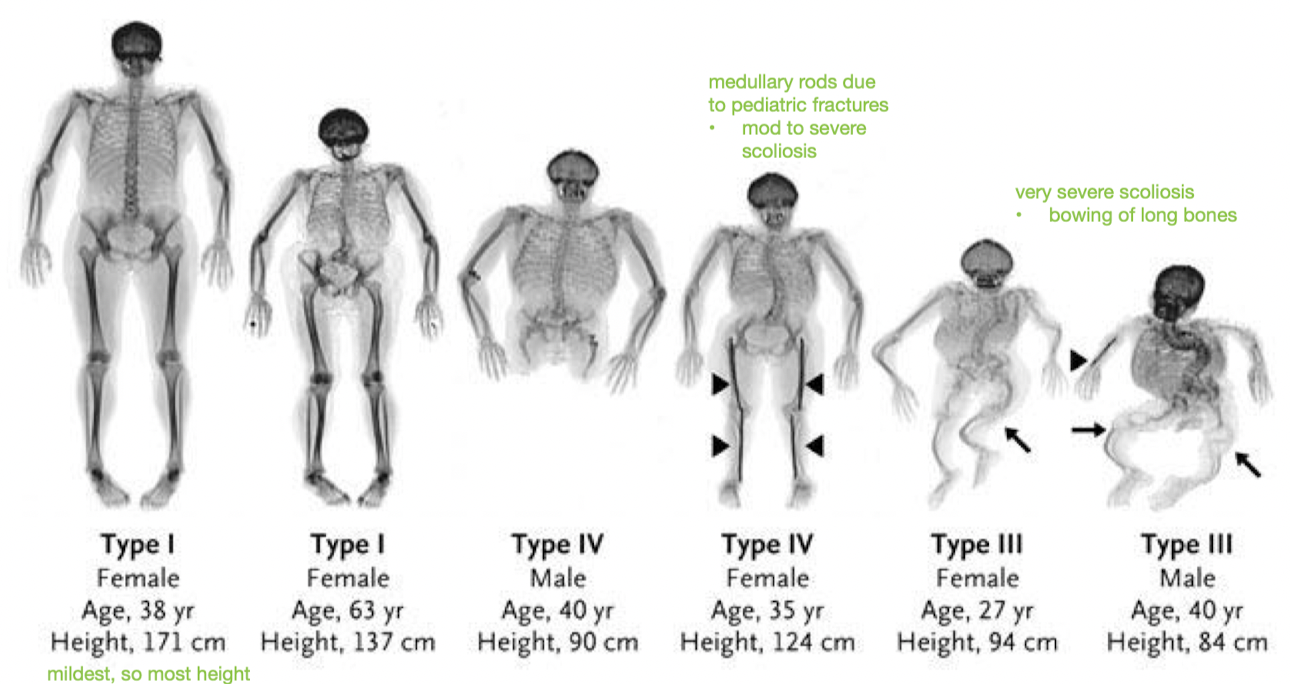
For diagnosis of OI, what type manifestations do you look for?
What type of biopsy for those w/ what deficits?
ID ___ defect or mutation present
X-rays and bone scans show evidence of multiple old ___ and skeletal ___
of the bone, where are fractures usually? Not where?
clinical manifestations
skin biopsy for those w/ collagen deficits
ID collagen defect of mutation present
evidence of multiple old fractures and skeletal deformities
fractures usually in the shaft of the bone, not epiphysis
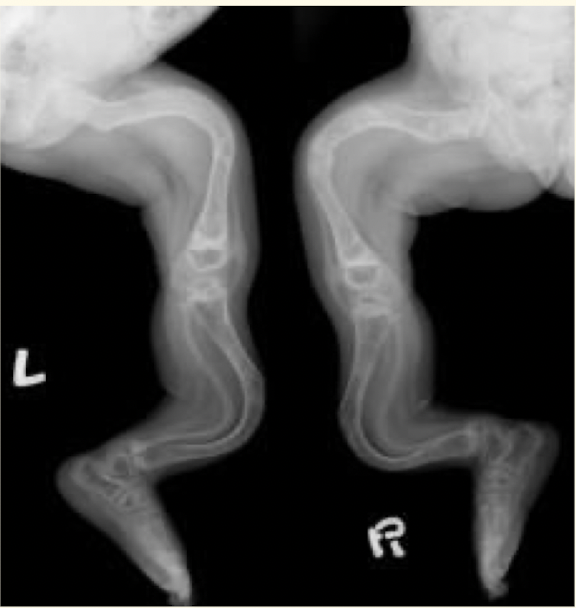
Exam:
What are the 3 things you should assess? Which test name?
What 2 techniques? Give 3 examples
How do you assess ROM? And not what?
pain assessment is important: FLACC
assessment of caregiving handling and positioning techniques
diapering, dressing, bathing
assess AROM and functional ranges
not PROM
Exam:
do you check for strength? What’s the correct way on checking it?
muscle strength through observation and palpation of muscles
Exam:
how do you assess for gross motor development? What 2 tests?
What is a good predictor of future walking ability?
PDMS-2, Bayley
sitting by 10 months = good predictor of future walking ability
Exam:
what are 3 functional tests you can do?
gait speed, timed walk tests, TUG
What are 2 other tests you can do? What 3 things do they look at?
PEDI or PEDI-CAT
function in ADLs, mobility, social/cognitive
What’s contraindicated ?
Never use what 2 things?
pull to sit is contraindicated
never use baby walker or jumping seats aka sling sit, which puts pressure on baby’s legs
Study the document!!!